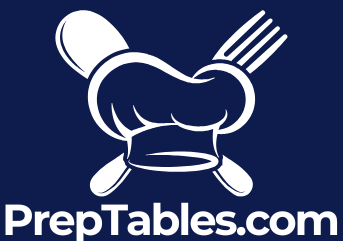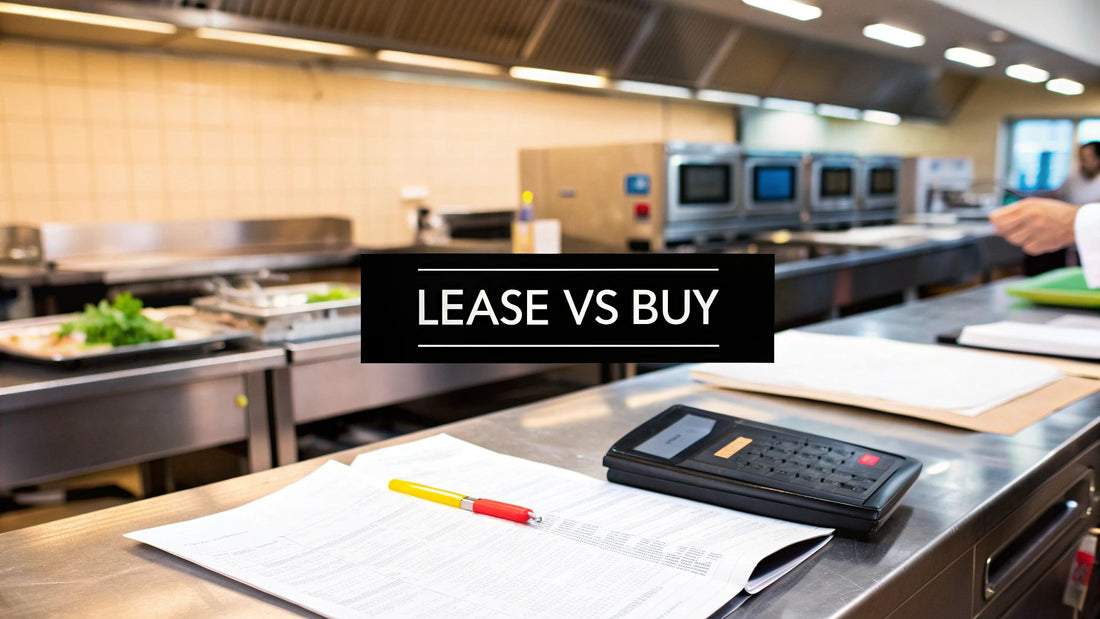
Equipment Leasing vs Buying Your Strategic Guide
Share
When it comes to outfitting your kitchen, the core debate between equipment leasing vs buying boils down to a simple trade-off. Buying gives you total ownership and can save you money in the long run. Leasing, on the other hand, keeps your initial costs low and gives you a ton of flexibility. The right move really depends on what your business needs most right now: building assets or protecting your cash flow and staying nimble.
Making the Right Choice: Equipment Leasing vs. Buying
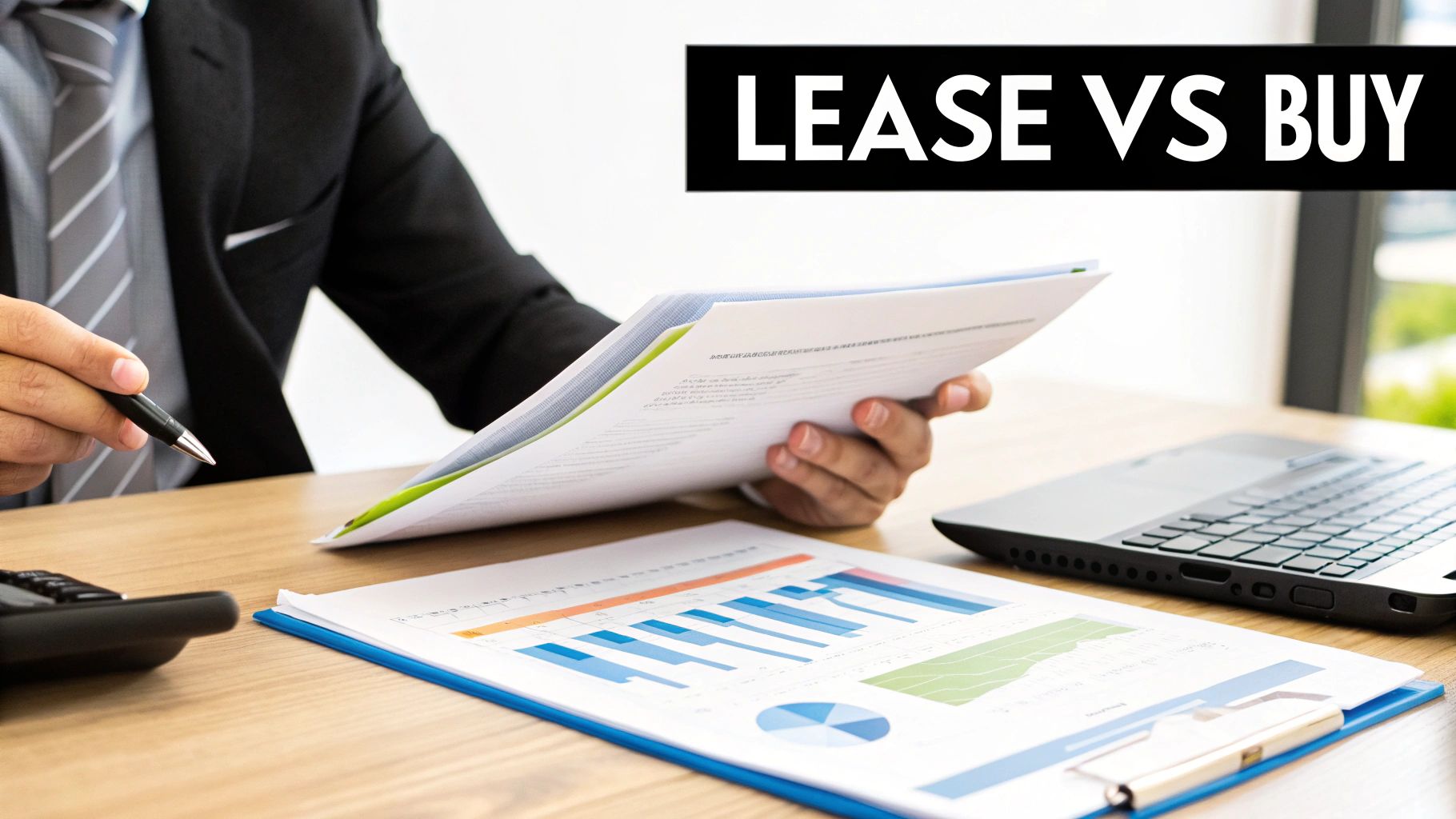
Deciding whether to lease or purchase your kitchen equipment is one of those foundational decisions that echoes through your business for years. It directly hits your cash flow, your balance sheet, and how you plan for the future. There’s no single "right" answer here; it’s all about what makes sense for your financial situation, your growth plans, and the daily realities of your kitchen.
Buying has the undeniable appeal of ownership. Once that mixer or oven is paid off, it’s yours. It becomes an asset on your books, which boosts your company's net worth. You have the freedom to modify it, sell it when you're ready, or even use it as collateral for a loan. Plus, you get to take advantage of tax depreciation, which is a nice perk.
But then there's leasing, which offers a kind of financial freedom that's tough to pass up, especially if you're just starting out or in a growth phase. It lets you sidestep massive upfront costs, turning a huge capital expense into a predictable, manageable monthly payment. This approach also makes it incredibly easy to stay current with technology. When your lease is up, you can simply swap out that old combi oven for the latest and greatest model.
To make this a bit clearer, let's break down the major differences side-by-side.
Leasing vs. Buying: A Quick Comparison
Think of this table as a cheat sheet. It lays out the core differences between leasing and buying, helping you see how each option stacks up against key business needs.
| Consideration | Leasing Equipment | Buying Equipment |
|---|---|---|
| Upfront Cost | Low to no initial down payment is required. | High upfront cost or a significant down payment. |
| Ownership | You do not own the equipment; you are renting it. | You have full ownership of the equipment. |
| Maintenance | Often included in the lease agreement. | Your full responsibility and an additional cost. |
| Technology | Easy to upgrade to newer models at lease end. | You are stuck with the asset, risk of obsolescence. |
| Tax Impact | Lease payments are typically tax-deductible expenses. | You can claim tax deductions through depreciation. |
| Long-Term Cost | Can be more expensive over the full term. | Generally lower total cost of ownership over time. |
Ultimately, whether you lease or buy depends on your unique circumstances. One path gives you ownership and lower long-term costs, while the other offers flexibility and preserves your precious capital.
Analyzing the Financial Impact on Your Business
Deciding between leasing and buying equipment goes way beyond the initial sticker price. This choice digs deep into your company's financial statements, cash flow, and overall financial health. A simple cost comparison just scratches the surface; you really need to look at the total financial picture.
When you purchase equipment, you’re adding an asset to your books. It shows up on your balance sheet, building equity for your business over time. Yes, the upfront cost is a big hit, but you gain the ability to claim depreciation tax benefits, which can lower your taxable income. This strategy is all about calculating the total cost of ownership (TCO)—that’s the purchase price, maintenance, repairs, and even what you might get back when you sell it down the road.
Leasing, on the other hand, is all about protecting your capital. Lease payments are usually treated as operational expenses, meaning they can often be fully deducted from your taxable income. This keeps a big chunk of debt off your balance sheet, which can make your business look more financially stable to lenders and investors. It might even improve your chances of securing other types of financing.
This infographic breaks down the main cost factors you'll be weighing.
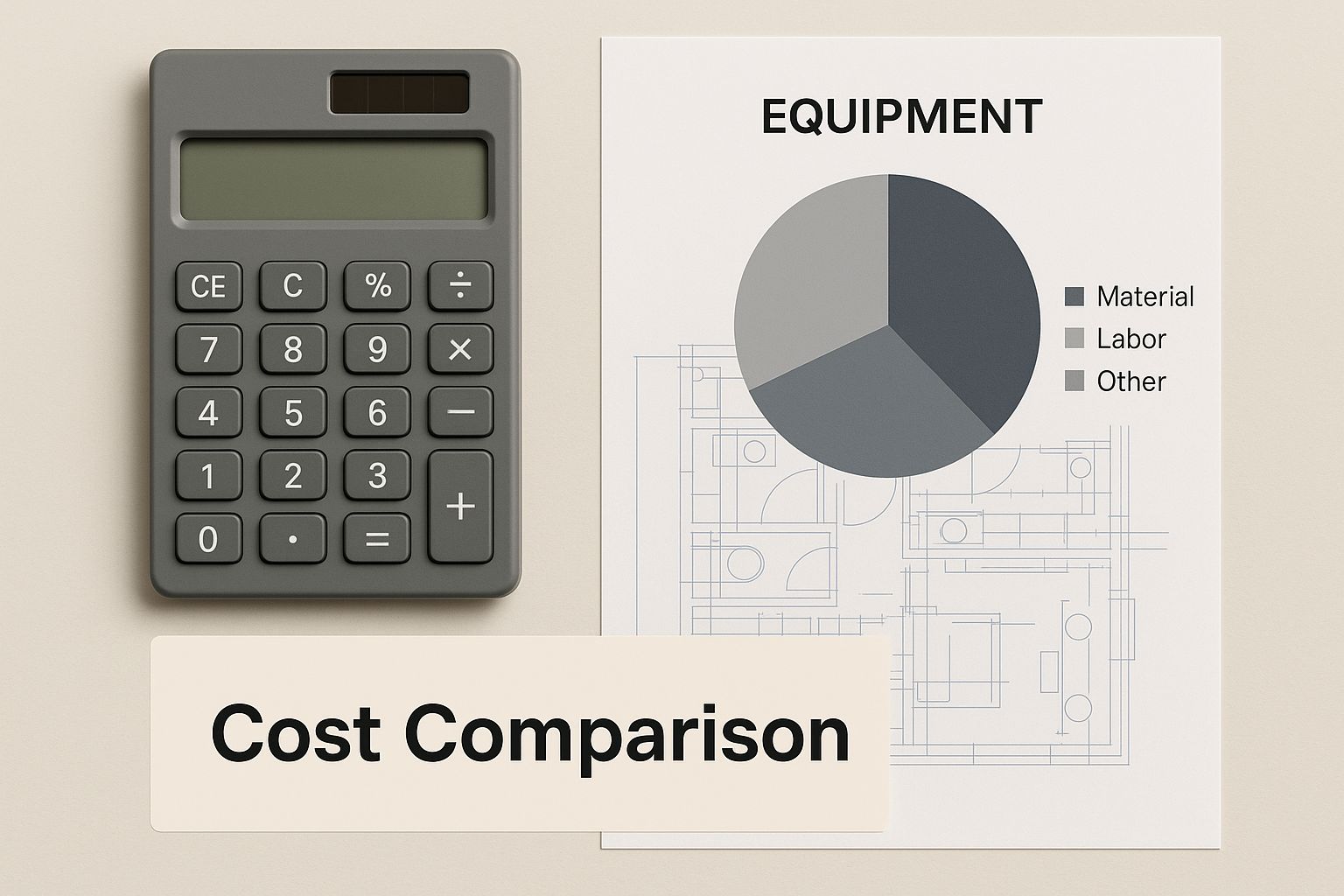
As you can see, buying involves a big initial spend but can lead to lower costs in the long run. Leasing smooths everything out into predictable monthly payments.
A Real-World Cost Scenario
To see how this works in practice, let's run some numbers. Imagine you need a $50,000 piece of equipment with an eight-year lifespan.
If you buy it with a 25% down payment and a four-year loan at 10% interest, your annual payments would be $11,830. The alternative is an eight-year lease at $8,500 annually. When you factor in a 40% tax rate and a 6% cost of capital, a net present value analysis shows buying costs $32,204 in today’s dollars versus $34,838 for leasing. You can dig into the full financial model and learn more about the nuances of lease-or-buy calculations.
Key Takeaway: Buying was cheaper in this specific case, but not by much. That small difference shows how non-financial factors—like keeping cash on hand, avoiding obsolete tech, and staying flexible—can easily tip the scales and make leasing the smarter strategic move.
Tax Implications and Your Bottom Line
How each option is treated by the IRS is a massive factor in this debate. Getting it right can seriously impact your bottom line.
- Leasing: Lease payments are usually seen as operating expenses. This means you can deduct the full payment from your revenue each year, giving you a consistent and predictable tax benefit for the entire lease term.
- Buying: When you buy, you can't just write off the whole purchase price at once. Instead, you deduct a portion of the cost each year through depreciation, spreading that tax benefit over the asset's useful life.
Ultimately, things like interest rates, your company's specific tax situation, and what you think the equipment will be worth later can totally change the financial outcome. Running a net present value analysis, just like in the case study, is the most accurate way to figure out which path gives you the best financial return.
How Each Option Affects Your Kitchen’s Agility
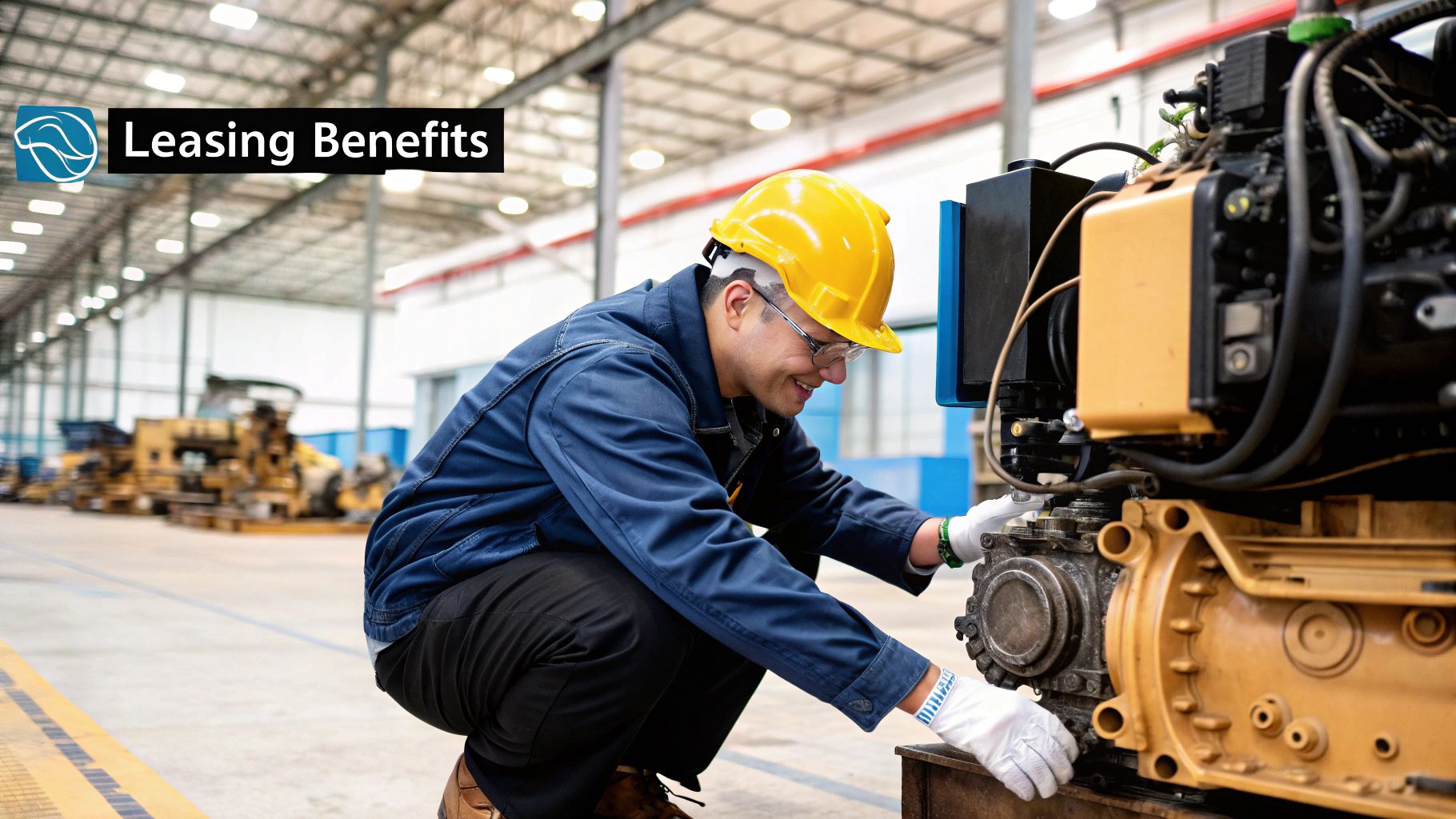
The numbers are just one part of the equipment leasing vs buying puzzle. How you run your kitchen—your ability to adapt, grow, and pivot—is just as critical. The wrong decision can chain you to outdated equipment, but the right one gives you a serious competitive edge.
Leasing almost always gives you more flexibility, especially when technology is moving at a breakneck pace. Think about those high-tech combi ovens or specialized blast chillers. Leasing lets you completely sidestep the risk of owning an obsolete hunk of metal in just a few years. When the lease is up, you simply swap it for the newest model, keeping your kitchen at peak efficiency.
This approach also takes the headache out of the equipment lifecycle. Instead of figuring out how to sell or scrap an old machine, you just return it. That frees up your team to focus on what they do best: cooking.
Ownership and Operational Freedom
On the other side of the coin, buying the equipment gives you total control. You can modify it, move it, or integrate it into a custom setup without asking anyone for permission. This is a huge deal for kitchens with very specific workflows or custom-built lines.
When you own it, you can run it as hard as you need to without worrying about hitting a usage limit buried in a lease agreement. For a high-volume spot where equipment runs nonstop, that kind of freedom is essential. If you can push your gear to its absolute limit to optimize your workflow, that translates directly to your bottom line. For more on this, check out our guide on how to improve workplace efficiency in a professional kitchen.
An Overlooked Detail: Security Agreements
Here’s a critical detail that often gets missed: how financing ties into your company’s bigger financial picture. When you buy equipment with a hefty loan, you’re almost certainly signing a General Security Agreement (GSA). This document gives the lender a security interest in nearly all of your company’s assets, both now and in the future. It’s not just the equipment—it’s everything.
In stark contrast, a lease typically uses a Personal Property Security Register (PPSR) interest that only applies to that specific piece of equipment. This is a massive distinction. It keeps the rest of your business assets free and clear, preserving your ability to get other financing down the road.
In short, leasing secures just the equipment, while a purchase loan can tie up your entire business. That difference is fundamental to staying nimble as you grow.
Understanding Different Types of Leases and Equipment
When you start digging into the leasing vs. buying debate, you quickly realize that "leasing" isn't a one-size-fits-all term. There are a few different ways these agreements are structured, and each one hits your books and your daily operations differently. Getting a handle on these distinctions is the first real step to making a smart call for your kitchen.
There’s a reason the global equipment leasing market is valued at around USD 120 billion in 2024 and growing. More and more businesses are realizing that access to equipment can be more valuable than outright ownership, especially when it comes to preserving cash and staying nimble. You can learn more about this global trend in equipment financing to see how it's changing the way businesses manage their assets.
For the most part, you'll run into two main types of leases.
- Operating Leases: Think of this as a long-term rental. You get to use the gear for a specific amount of time, and your payments are just an operating expense. When the term is up, you hand the equipment back. It’s a great fit for stuff that gets outdated fast, like certain tech-heavy appliances.
- Finance Leases (or Capital Leases): This one feels a lot more like a loan. The lease runs for most of the equipment's expected lifespan, and you’ll usually get an option to buy it for a set price at the end. From an accounting perspective, this equipment actually shows up as an asset on your balance sheet.
Grounding the Decision with Real Equipment
To pull this out of the clouds, let's talk about something every kitchen has: stainless steel prep tables. The sheer variety in this one category shows why the right choice really hinges on the specific piece of equipment. After all, a basic work table is a completely different animal than a complex, refrigerated prep unit.
Your standard stainless steel work tables are the unsung heroes of the kitchen. They’re built like tanks, last forever, and there's virtually no tech to become obsolete. You can find them in various configurations:
- Open Base Tables: Simple and versatile, offering easy access to storage underneath.
- Tables with Undershelves: Provide convenient, built-in storage for supplies and small appliances.
- Enclosed Base/Cabinet Tables: Keep stored items clean and out of sight, perfect for organized kitchens.
- Wall-Mounted Tables: Save floor space, making them ideal for smaller or cramped work areas.
For an asset you’ll be leaning on for a decade or more, buying it outright almost always makes the most financial sense.
Choosing between leasing and buying isn't just a financial calculation; it's an operational one. The decision for a simple prep table is fundamentally different from the one for a high-tech, refrigerated pizza prep station.
Specialized Prep Tables and the Leasing Advantage
The whole conversation changes, though, when we start looking at more specialized and tech-heavy equipment. These units have more moving parts that can break and technology that can feel ancient in just a few years. Suddenly, leasing starts to look a lot more appealing.
Think about these examples:
- Sandwich and Salad Prep Tables: These aren't just tables; they’re workstations with built-in refrigerated wells for ingredients and often a refrigerated cabinet base. They have complex cooling systems and compressors, which means more things can go wrong. A lease often bundles in a service package, saving you from the headache and cost of surprise repair bills.
- Pizza Prep Tables: Much like the sandwich units, these have refrigerated rails for toppings and a refrigerated base for dough storage. They often feature a heavy-duty marble or granite top for working with dough. With all that mechanical complexity and the high cost of replacement parts, a lease can give you a predictable monthly cost and some much-needed peace of mind.
For these kinds of specialized tables, leasing lets you hold onto your capital, wrap maintenance costs into one neat payment, and easily upgrade to a newer, better model when your term is up. It’s all about keeping your kitchen running smoothly without the long-term baggage and financial risk of ownership.
When Leasing Is the Smartest Move
The whole equipment leasing vs. buying debate isn't just about dollars and cents; it’s about your game plan. Sure, buying a piece of equipment means you own it, building equity over time. But leasing gives you something else entirely: agility. It keeps your cash free, which is a massive advantage in certain situations.
Let's get past the generic pro/con lists and dig into the specific times when leasing isn't just an alternative—it's the smartest strategic move you can make for your kitchen.
For any brand-new restaurant or food business, cash is king. It's the lifeblood. Leasing completely sidesteps the gut-punch of a huge upfront payment for a full kitchen build-out. That massive one-time cost gets broken down into predictable monthly payments. This protects your startup capital, freeing it up for things that actually bring customers in the door, like marketing, inventory, or just making payroll.
Navigating Rapid Technological Change
In certain corners of the kitchen world, technology moves fast. A top-of-the-line combi oven or a high-tech blast chiller bought today could feel like a dinosaur in just a few years. Buying that equipment can feel like a trap.
Leasing is your way out. It effectively outsources the risk of your gear becoming obsolete. When the lease is up, you simply send the old unit back and upgrade to the latest, most efficient model. This keeps your kitchen on the cutting edge without getting stuck holding the bag on an outdated asset. You always have the best tools for the job.
By leasing equipment with rapidly changing technology, you are essentially buying an insurance policy against obsolescence. You gain access to the latest features and efficiencies without the long-term financial burden of ownership.
Scaling and Short-Term Needs
Leasing is the perfect play for businesses with needs that change or are just temporary. Think about a catering company that suddenly needs a dozen specialized holding cabinets for a massive one-off event. Or a pop-up concept that needs a complete kitchen setup for a six-month run.
Leasing provides the exact equipment you need, for the exact time you need it, without the burden of a permanent purchase. This "asset-light" model is also fantastic for rapid growth. As your business expands, you can add equipment easily without having to find huge chunks of capital for every new location or big contract.
Predictable Costs and Maintenance
Finally, leasing just makes your budget and maintenance schedule simpler. Most lease agreements bundle service and repair costs right into a single, predictable monthly payment. This protects you from the shock of a sudden, expensive equipment failure—a headache every owner knows all too well.
A solid service plan is a non-negotiable part of running a kitchen, and you can learn more about building one in our guide on commercial kitchen equipment maintenance. By wrapping these costs into your lease, you flatten out your expenses and drastically reduce downtime, which makes your financial planning a whole lot more reliable.
When Buying Your Equipment Makes Sense
While leasing has its perks, the whole equipment leasing vs buying debate isn't over until you look at when ownership is the smarter financial move. For an established restaurant with predictable cash flow and a solid long-term plan, buying your key assets is almost always the best way to get the lowest total cost of ownership. It also gives you a lot more freedom.
When you decide to buy, you're making a long-term investment in the heart of your operation.
This path makes the most sense for equipment that has a long, predictable lifespan. We're talking about the foundational workhorses of your kitchen—the stuff that isn't going to be obsolete in a few years. Think industrial ovens, heavy-duty mixers, or a bulletproof stainless steel work table. These pieces are built to last a decade or more, making that upfront cost a very logical investment.
Building Equity and Maximizing Value
When you buy, you’re not just spending cash; you're building equity. That equipment becomes a real asset on your balance sheet, making your company look stronger financially. Owning it gives you total control. You can modify it, move it, or run it into the ground 24/7 without ever worrying about what your lease agreement says.
On top of that, owning the equipment unlocks some powerful tax advantages. Instead of just writing off your monthly lease payments, you can claim depreciation over the asset's lifespan. This can seriously lower your taxable income, and it's a financial lever that leasing just can't pull.
Key Insight: Buying is a strategic move for the foundational equipment that forms the backbone of your kitchen. For these core pieces, the long-term financial wins from depreciation and asset ownership often crush the initial cash outlay.
When an Asset Is a Core Investment
Purchasing is the clear winner when a piece of equipment is absolutely critical to your daily revenue. A pizzeria isn’t just acquiring its primary deck oven; it's making a core investment that will pay off for the next ten years. The same goes for a bakery's main dough sheeter or a butcher shop's band saw.
The same logic applies to essential infrastructure like refrigeration. For mission-critical assets you'll be using day-in and day-out for years, buying is typically the default choice. You can see the huge range of options out there when you check out our guide on commercial refrigerator units. Buying these key pieces cuts out the endless cycle of lease payments and locks in a lower total cost over the equipment’s entire life.
Answering Your Key Questions
When you get down to the brass tacks of the equipment leasing vs. buying debate, it usually boils down to a handful of critical questions. Getting clear on these details will show you which path truly fits your kitchen's financial and operational plans.
What Are the Main Tax Differences?
The biggest distinction is how you handle deductions. When you lease, your monthly payments are typically just an operating expense. This means you can deduct the full amount from your revenue every year, giving you a steady, predictable tax benefit.
Buying, on the other hand, means the equipment becomes an asset on your books. You can’t write off the whole cost in one go. Instead, you claim a portion of it each year through depreciation over the equipment’s expected useful life.
Can I Buy the Equipment After My Lease Ends?
Yes, that’s often an option. Many lease agreements, especially what are known as finance leases, come with a purchase option at the end of the term.
The most common setup is a fair market value (FMV) buyout, where you can buy the gear for whatever it's worth at that moment. Some other agreements might offer a fixed, predetermined price from the start.
How Does Each Choice Affect Business Loans?
Each route impacts your balance sheet differently, which can definitely influence your ability to get future financing. Taking out an equipment loan adds both an asset and a liability to your balance sheet.
In contrast, an operating lease keeps that big liability off your books entirely. This can make your company look less leveraged to potential lenders and help improve key financial ratios.
Ready to find the perfect equipment for your kitchen? PrepTables.com offers a premium selection of stainless steel work tables, specialized prep stations, and commercial refrigeration to build a durable, efficient workspace. Find your kitchen essentials here.
